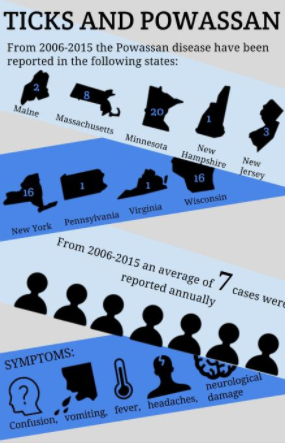By: Anna Rhoads ’19
Powassan, a tick-borne virus, is hitting the Northeast with more momentum than ever. The infection is said to be worse than Lyme disease and in many cases, deadly.
Due to the warmer winters, places like Westport have seen an increase in the tick population. Another reason is the growth in the amount of animals that carry ticks. Deer and mice are the two biggest offenders. Their population rise also is linked to the warmer winters, as Warmer winters mean a higher chance for winter survival.
“I’ve noticed a lot of deer recently which I assume means a lot more ticks. When I was three I actually almost got Lyme disease. It was really scary and opened up my eyes to how dangerous the bugs really are,” Brooke Redmer ’19 said.
Jerome Goddard, a medical entomologist at Mississippi State University, credits tick’s success to the fact that “they have few predators. Some birds, including guinea fowl and backyard chickens, will eat them, but they don’t do much to control tick populations.” He also said that ticks are “so adaptable. For example, the black-legged tick has adapted to a wide variety of small rodents, birds, and large mammal hosts.”
According to Extension, a part of the education program, Cooperative Extension System, Entomologists like Goddard say that “other factors such as shifts in populations of hosts and reservoir animals, changes to local landscapes, human settlements encroaching on wildlife habitats and into areas of abundant tick populations, are playing a role.
This rise in ticks also means a rise in infections, one being Powassan. In an interview, Karen Thompson, a Staples science teacher and researcher on ticks at Western Connecticut State University, explains how all ticks are born free of the disease but obtain it from small rodents. When these infected ticks go to get a blood meal they can transmit the deadly virus to their host. According to the New York State Department of Health, “Nymphal deer ticks efficiently transmitted POW virus to naive mice after as few as 15 minutes of attachment,” making the transmission much faster compared to that of Lyme disease.
There are two strains of the Powassan virus, known as lineage 1 POW virus and lineage 2 POW virus. Although the virus is rare, it is becoming more common with the rise in rodents and deer. The Hartford Courant states that only 50 cases of Powassan have been identified in the U.S. since 2004, but that this number is increasing. The Courant also states that recently in Connecticut, Powassan was detected in ticks from Bridgeport and Branford, showing that the virus is still a threat. Although Lyme disease is much more common, it’s symptoms are much less severe compared to Powassan.
Thompson comments on these predictions, “I don’t foresee it becoming like a Lyme disease but certainly I would see the numbers, just like any infectious disease, increase over time. There is predicted to be over 300,000 cases of Lyme disease this year in the United States, so probably not. It’s been around for a lot longer than people realize.”
People with Lyme disease usually recover relatively fast and there are rarely deaths involved. Powassan, on the other hand, proves to have a less-successful recovery and, in many cases, no recovery at all. According to Dr. Jennifer Lyons, chief of the Division of Neurological Infections and Inflammatory Diseases at Brigham and Women’s Hospital in Boston, “About 15% of patients who are infected and have symptoms are not going survive.” And on an even larger scale, “Of the survivors, at least 50% will have long-term neurological damage that is not going to resolve.”
If the victim of Powassan does not fall into that 15%, there are distinct symptoms that come with the infection. According to the Centers for Disease Control and Prevention, signs and symptoms of Powassan include seizures, confusion, memory loss, vomiting, weakness, headaches and fever and as Dr. Lyons mentioned, long-term neurological damage.
The Center for Disease Control and Prevention also states, “There is no specific treatment, but people with severe POW virus illnesses often need to be hospitalized to receive respiratory support, intravenous fluids, or medications to reduce swelling in the brain.”
It’s tick season and everyone is at risk for these tick-borne viruses like Powassan or Lyme. The Center for Disease Control and Prevention says that using bug spray, consistently checking for ticks and showering after being outdoors can reduce your chances of getting ticks and the diseases they bring with them.
Image courtesy of google images














































